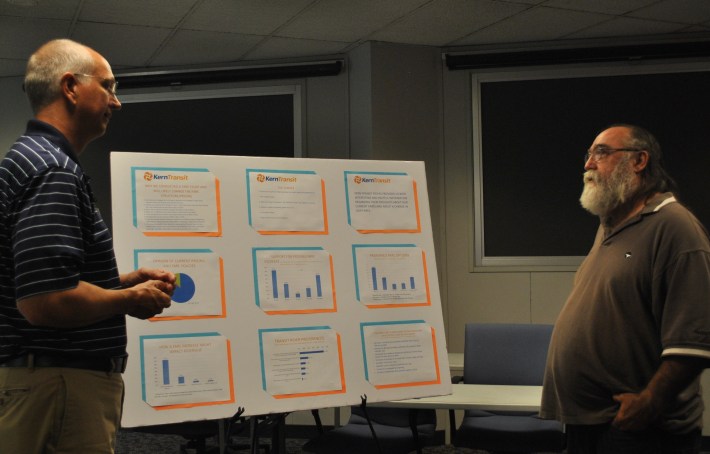
Kern Transit, the transit system that serves rural Kern County, held two public meetings recently to present the findings of a fare study and survey of its users. This summer, the agency bought several new vehicles and overhauled its schedule. Now it is proposing a fare increase of fifty cents.
Attendance was slim at the meetings, but those who did attend were generally positive about the changes.
Streetsblog recently spoke with the agency’s executive director, Bob Neath, about the overhaul of the system, the first it had seen in nearly thirty years. Major funds from transit grants allowed the agency to purchase new buses, hire consultants, and install tracking capabilities on the buses. The results of the overhauls, specifically customer satisfaction of the new schedule and the potential fare raise, were the subject of a customer survey. The feedback has been mostly positive.
Neath spoke about the public meeting that took place in early September in Lake Isabella, a mountain community in Kern. “Last year there were forty people with complaints,” said Neath. “We have had a year with the new schedule, and at this last meeting I think five people showed up. They had positive things to say and [they] were mostly happy with the new system.”
“That isn't to say we don't have room for improvement,” he added.
That potential for growth may be possible thanks to new revenues from raising fares, including identifying and fixing inconsistencies in the fare structure. Fares at Kern County Transit have not changed in ten years--in some places they haven’t changed for 25 years.
At the meetings, the agency presented the results of a survey of Kern Transit riders. Over 85 percent of those surveyed--nearly 240 riders-- thought that the pricing structure was “just right.” Yet 72 percent of those people said that they would ride the same number of times even if the fare were increased.
The survey found that riders would especially support an increase if new fare media were offered. Neath acknowledged that it was “the number one thing that riders are asking for,” and confirmed that the agency would create a monthly pass system by spring 2016. He also said they would explore the idea of introducing some kind of smart card, TAP card, or re-loadable fare card.
The survey also asked riders about the current fare structure, and found that inconsistencies throughout the system are confusing. Neath says that this new knowledge has spurred the agency to find a way to standardize fares across the system.
The meeting in Bakersfield on September 26 was even more sparsely attended, with only two people showing up. It’s not clear why there was such sparse attendance; it may be that people were generally happy with the system and had nothing to add to their comments on the survey, or that riders are too busy to show up.
The agency has a very small staff, but they may want to look into doing stronger outreach. “It is about marketing,” said Neath. “The four of us can’t do that.” Transit marketing is a niche business, he said, and they need time to figure it out. “Once the fare study is done, we will push for that,” he said.
Yet, the small number of staff can be an asset for the agency. Neath talked about a problem one disabled rider had at the meeting in Lake Isabella. She came to the meeting to complain about problems getting her disabled fare discount. A member of Neath's staff heard this, snapped a picture with her smartphone, filled out an application for her, and send her the updated ID card that day.
“Being a small agency, we can do things like that,” explained Neath.
One attendee at the Bakersfield meeting was Bakersfield resident Anthony Fullington, who wanted to see more connecting routes to L.A. Metro in Lancaster. Neath assured him that the agency is looking to improve those connections for its riders.
Another attendee was Troy Hightower, a member of Kern Council of Governments. Hightower takes transit about two to five times a month, and had positive comments about Kern Transit's improvements. He also had ideas about more that could be done.
“The new buses are really nice, especially on the longer rides,” he said. “[Riding] the old buses, I could barely make it to Tehachapi,” which is only about 45 miles away. Hightower said he would be okay with a fare increase, but suggested that any increase be countywide.
He also commented on the lack of bus shelters throughout the system. “More transit shelters would be nice, especially in the desert when the winds kick up,” he said. Sometimes the waits at stops in desert towns like Mojave and Lancaster can be long, he said, and a shelter is necessary.
Director Neath also spoke about how important it was to provide service even if ridership is very low, because some people don’t have any other way to get around. “If somebody is riding it, we will keep running it,” he said. This is a big claim, especially from a small transit agency with a wide-ranging service area.
“This is a change in mindset,” he explains. “In the past, it was always 'It is what it is.' Now, we have been afforded a lot of freedom [to do our jobs]. We are not just accepting the status quo.”





